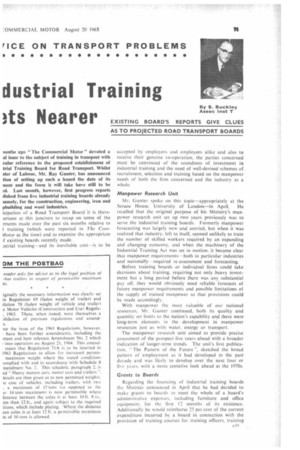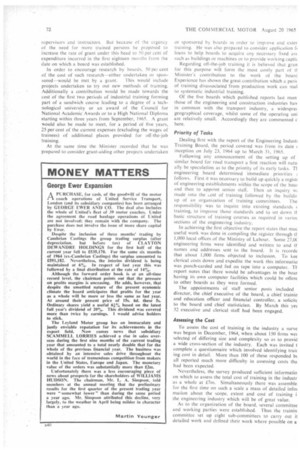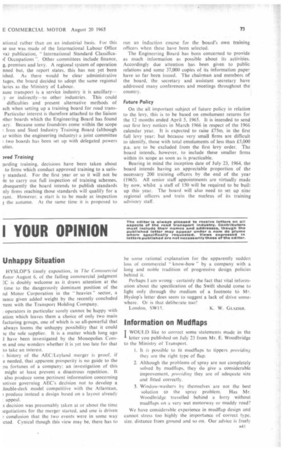dustrial Training
Page 73

Page 74

Page 75

If you've noticed an error in this article please click here to report it so we can fix it.
AsNearer EXISTING BOARD'S REPORTS GIVE CLUES By S. Buckley Assoc I nst T
AS TO PROJECTED ROAD TRANSPORT BOARDS
tonths ago " The Commercial Motor" devoted a at issue to the subject of training in transport with cular reference to the proposed establishment of trial Training Board for Road Transport. Whilst ster of Labour, Mr. Ray Gunter, has announced lion of setting up such a board the date of its iient and the form it will take have still to be d. Last month, however, first progress reports dished from five industrial training boards already tamely, for the construction, engineering, iron and obuilding and wool industries.
icipation of a Road Transport Board it is thereortune at this juncture to recap on some of the :ments made over the past six months relative to I training (which were reported in The Coonlifotor at the time) and to examine the appropriate f existing boards recently made.
Atrial training—and its inevitable cost—is to be
accepted by employers and employees alike and also to receive their genuine co-operation, the parties concerned must be convinced of the soundness of investment in industrial training and the need of well-devised schemes of. recruitment, selection and training based on the manpower needs of both the firm concerned and the industry as a whole.
Manpower Research Unit
Mr. Ciunter spoke on this topic—appropriately at the Senate House. University of London—in April, He recalled that the original purpose of his Ministry's manpower research unit set up two years previously was to serve the industrial training boards. Formerly manpower forecasting was largely new and untried, but when it was realized that industry, left to itself, seemed unlikely to train the number of skilled workers required by an expanding and changing economy, and when the machinery of the Industrial Training Act was set in motion, it became clear that manpower requirements--both in particular industries and nationally—required re-assessment and forecasting.
Before training boards or individual firms could take decisions about training, requiring not only ,heavy investment but a long period before there was any substantial pay off, they would obviously need reliable forecasts of future manpower requirements and possible limitations of the supply of trained manpower so that provisions could be made accordingly, With manpower the most valuable of our national resources, Mr. Gunter continued, both its quality and quantity set limits to the nation's capability and there were long-term elements in the development in manpower resources just as with water, energy or transport. • The manpower research unit aimed to provide precise assessment of the prospect five years ahead with a broader indication of longer-term trends. The unit's first publication. The Pattern of the Future ", sketched the broad pattern of employment as it had developed in the past decade and was likely to develop over the next four or five years, with a more tentative look ahead at the 1970s.
Grants to Boards Regarding the financing of industrial training boards the Minister announced in April that he had decided to make grants to boards to meet the whole of a board's administrative expenses, including furniture and office equipment, for the first 12 months of its existence. Additionally he would reimburse 25 per cent of the current expenditure incurred by a board in connection with the provision of training courses for training officers, training
supervisors and instructors. But because of he urgency of the need for more trained persons he proposed to increase the rate of grant under this head to 50 per cent of expenditure incurred in the first eighteen months from the date on which a board was established.
In order to encourage research by boards, 50 per cent of the cost of such research—either undertaken or sponsored—would be met by a grant. This would include projects undertaken to try out new methods of training. Additionally a contribution would be made towards the cost of the first two periods of industrial training forming part of a sandwich course leading to a degree of a technological university or an award of the Council for National Academic Awards or to a High National Diploma starting within three years from September, 1965. A grant would also be made to meet, for a period of five years, 25 per cent of the current expenses (excluding the wages of trainees) of additional places provided for off-the-job training.
At the same time the Minister recorded that he was prepared to consider grant-aiding other projects undertaken or sponsored by hoards m order to improve and ester training. He was also prepared to consider application fl loans to help boards to acquire any necessary fixed ass such as buildings or machines or to provide working capit Regarding off-the-job training it is believed that gran for this purpose will form the most costly part of ti Minister's contribution to the work of the board Experience has shown the great contribution which a perk of training disassociated from production work can mal to systematic industrial training.
Of the five boards which published reports last mon those of the engineering and construction industries hay in common with the transport industry, a widesprez geographical coverage, whilst some of the operating uni are relatively small. Accordingly they arc commented c here.
Priority of Tasks Dealing first with the report of the Engineering lndusti Training Board, the period covered was from its date inception on July 23, 1964 up to March 31, 1965.
Following any announcement of the setting up of similar board for road transport a first reaction will natu ally be speculation as to the priority of its early tasks. TI engineering board determined immediate priorities ; follows. First it was necessary to build up quickly a registi of engineering establishments within the scope of the boat and then to appoint senior staff. Then an inquiry w: made into the cost of training followed by the buildir up of an organization of training committees. The responsibility was to inquire into existing standards r training, to improve those standards and to set down tl basic structure of training courses as required in variot sections of the engineering industry.
In achieving the first objective the report slates that muc useful work was done in compiling the register through ti 1,000 local offices of the Ministry of Labour. Some 27,0( engineering firms were identified and written to and names and addresses sent to the board. It is recorde that about 1,000 firms objected to inclusion. To kee clerical costs down and expedite the work this informatio was punch-carded and fed on tape into a computer. Ti report notes that there would be advantages in the boar having its own computer facilities which could be offere to other boards as they were formed.
The appointments of staff senior posts included director, the chief executive of the board, a chief trainir and education officer and financial controller, a solicit( to the board and chief statistician. By March this yet 32 executive and clerical staff had been engaged.
Assessing the Cost To assess the cost of training in the industry a surve was begun in December, 1964, when about 150 firms wei selected of differing size and complexity so as to provicl a wide cross-section of the industry. Each was invited t complete a questionnaire which involved identifying trair ing cost in detail. More than 100 of these responded In all reported much more difficulty in assessing costs tha had been expected.
Nevertheless, the survey produced sufficient informatio on which to assess the total cost of training in the industr as a whole at Om. Simultaneously there was assemble for the first time on such a scale a mass of detailed infoi mation about the scope. extent and cost of training i the engineering industry which will be of great value.
As to the organization of the board, several committee and working parties were established. Thus the trainin committee set up eight sub-committees to carry out it detailed work and defined their work where possible on a
ational rather than on an industrial basis. For this se use was made of the International Labour Office
va) publication, International Standard Classificaif Occupations ". Other committees include finance, g, premises and levy. A regional system of operation nned but, the report states, this has not yet been ished. As there would be clear administrative tages, the board decided to adopt the same regional lanes as the Ministry of Labour.
ause transport is a service industry it is ancillary-y or indirectly—to other industries. This could difficulties and present alternative methods of ach when setting up a training board for road transParticular interest is therefore attached to the liaison )ther boards which the Engineering Board has found ary. Because some foundries come within the scope : Iron and Steel Industry Training Board (although sr within the engineering industry) a joint committee two boards has been set up with delegated powers uties.
wed Training
tarding training, decisions have been taken about to firms which conduct approved training to a satisy standard. For the first year or so it will not be ■ le to carry out full inspection of training scbemes. Asequently the board intends to publish standards nly firms reaching those standards will qualify for a rant. However, a start is to be made at inspection g the autumn. At the same time it is proposed to run an induction course for the board's own training officers when these have been selected.
The Engineering Board has been concerned to provide. as much information as possible about its activities. Accordingly due attention has been given to public relations and some 37,000 copies of its information paper have so far been issued. The chairman and members of the board, the secretary and assistant secretary have addressed many conferences and meetings throughout the country.
Future Policy
On the all important subject of future policy in relation to the levy, this is to be based on emolument returns for the 12 months ended April 5, 1965. It is intended to send. out first levy notices in March 1966 in respect of the 1966 calendar year_ It is expected to raise £75m. in the first full levy year; but because very small firms are difficult to identify, those with total emoluments of less than £5,000 p.a. are to be excluded from the first levy order. The board intends, however, to include these smaller firms within its scope as soon as is practicable.
Bearing in mind the inception date of July 23, 1964, the board intends having an appreciable proportion of the necessary 200 training officers by the end of the year (1965). All senior staff appointments are virtually made by now, whilst a staff of 150 will be required to be built up this year. The board will also need to set up nine regional officers and train the nucleus of its training advisory staff.




















































































































